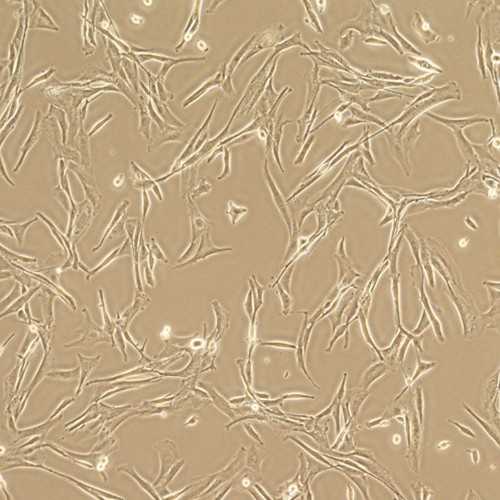Canine Hemangiosarcoma Cell Line (DD-1)
DD1 is a canine hemangiosarcoma cell line derived from a tumor in the spleen of a 11-year old male Golden Retriever/Great Pyrenees mix.
Hemangiosarcoma is a rapidly growing, highly invasive variety of cancer, occurring commonly in dogs. It is a sarcoma arising from the lining of blood vessels. A frequent cause of death is the rupturing of this tumor, causing the patient to rapidly bleed to death.
From the laboratory of Jaime F. Modiano, VMD, PhD, University Minnesota, Twin Cities.
DD1 is a canine hemangiosarcoma cell line derived from a tumor in the spleen of a 11-year old male Golden Retriever/Great Pyrenees mix.
Hemangiosarcoma is a rapidly growing, highly invasive variety of cancer, occurring commonly in dogs. It is a sarcoma arising from the lining of blood vessels. A frequent cause of death is the rupturing of this tumor, causing the patient to rapidly bleed to death.
From the laboratory of Jaime F. Modiano, VMD, PhD, University Minnesota, Twin Cities.
This product is for sale to Nonprofit customers only. For profit customers, please Contact Us for more information.
Specifications
| Product Type: | Cell Line |
| Name: | DD1 |
| Cell Type: | Hemangiosarcoma |
| Accession ID: | CVCL_0C94 |
| Morphology: | Spindle |
| Source: | Spleen |
| Organism: | Dog |
| Biosafety Level: | 2 |
| Growth Conditions: | Ham's F12, 10% FBS, 0.05mg/ml ECGS, 0.01mg/ml heparin, 10mM HEPES Buffer, 100ug/ml Primocin |
| Subculturing: | Split 1:3-1:5 when cells reach ~80% confluence. |
| Cryopreservation: | 90%FBS/10% DMSO |
| Mycoplasma Tested: | Yes |
| Storage: | Liquid nitrogen |
| Shipped: | Dry ice |
Provider
From the laboratory of Jaime F. Modiano, VMD, PhD, University Minnesota, Twin Cities.
References
- Fosmire SP, Dickerson EB, Scott AM, Bianco SR, Pettengill MJ, Meylemans H, Padilla M, Frazer-Abel AA, Akhtar N, Getzy DM, Wojcieszyn J, Breen M, Helfand SC, Modiano JF. Canine malignant hemangiosarcoma as a model of primitive angiogenic endothelium. Lab Invest. 2004 May;84(5):562-72.
- Frazer-Abel AA, Baksh S, Fosmire SP, Willis D, Pierce AM, Meylemans H, Linthicum DS, Burakoff SJ, Coons T, Bellgrau D, Modiano JF. Nicotine activates nuclear factor of activated T cells c2 (NFATc2) and prevents cell cycle entry in T cells. J Pharmacol Exp Ther. 2004 Nov;311(2):758-69. Epub 2004 Jul 1.
- Dickerson EB, Thomas R, Fosmire SP, Lamerato-Kozicki AR, Bianco SR, Wojcieszyn JW, Breen M, Helfand SC, Modiano JF. Mutations of phosphatase and tensin homolog deleted from chromosome 10 in canine hemangiosarcoma. Vet Pathol. 2005 Sep;42(5):618-32.
- Lamerato-Kozicki AR, Helm KM, Jubala CM, Cutter GC, Modiano JF. Canine hemangiosarcoma originates from hematopoietic precursors with potential for endothelial differentiation. Exp Hematol. 2006 Jul;34(7):870-8.
- Tamburini BA, Trapp S, Phang TL, Schappa JT, Hunter LE, Modiano JF. Gene expression profiles of sporadic canine hemangiosarcoma are uniquely associated with breed. PLoS One. 2009 May 20;4(5):e5549. doi: 10.1371/journal.pone.0005549.
- Tamburini BA, Phang TL, Fosmire SP, Scott MC, Trapp SC, Duckett MM, Robinson SR, Slansky JE, Sharkey LC, Cutter GR, Wojcieszyn JW, Bellgrau D, Gemmill RM, Hunter LE, Modiano JF. Gene expression profiling identifies inflammation and angiogenesis as distinguishing features of canine hemangiosarcoma. BMC Cancer. 2010 Nov 9;10:619. doi: 10.1186/1471-2407-10-619.
- Schappa JT, Frantz AM, Gorden BH, Dickerson EB, Vallera DA, Modiano JF. Hemangiosarcoma and its cancer stem cell subpopulation are effectively killed by a toxin targeted through epidermal growth factor and urokinase receptors. Int J Cancer. 2013 Oct 15;133(8):1936-44. doi: 10.1002/ijc.28187. Epub 2013 Apr 25.
- Gorden BH, Kim JH, Sarver AL, Frantz AM, Breen M, Lindblad-Toh K, O'Brien TD, Sharkey LC, Modiano JF, Dickerson EB. Identification of three molecular and functional subtypes in canine hemangiosarcoma through gene expression profiling and progenitor cell characterization. Am J Pathol. 2014 Apr;184(4):985-95. doi: 10.1016/j.ajpath.2013.12.025. Epub 2014 Feb 11.
- Kim JH, Frantz AM, Anderson KL, Graef AJ, Scott MC, Robinson S, Sharkey LC, O'Brien TD, Dickerson EB, Modiano JF. Interleukin-8 promotes canine hemangiosarcoma growth by regulating the tumor microenvironment. Exp Cell Res. 2014 Apr 15;323(1):155-64. doi: 10.1016/j.yexcr.2014.02.020. Epub 2014 Feb 25.
- Gorden BH, Saha J, Khammanivong A, Schwartz GK, Dickerson EB. Lysosomal drug sequestration as a mechanism of drug resistance in vascular sarcoma cells marked by high CSF-1R expression. Vasc Cell. 2014 Oct 1;6:20. doi: 10.1186/2045-824X-6-20. eCollection 2014.
- Rodriguez AM, Graef AJ, LeVine DN, Cohen IR, Modiano JF, Kim JH. Association of Sphingosine-1-phosphate (S1P)/S1P Receptor-1 Pathway with Cell Proliferation and Survival in Canine Hemangiosarcoma. J Vet Intern Med. 2015 Jul;29(4):1088-97. doi: 10.1111/jvim.13570. Epub 2015 Jun 25.
- Lin W, Modiano JF, Ito D. Stage-specific embryonic antigen: determining expression in canine glioblastoma, melanoma, and mammary cancer cells. J Vet Sci. 2017 Mar 30;18(1):101-104. doi: 10.4142/jvs.2017.18.1.101. PubMed PMID: 27456773; PubMed Central PMCID: PMC5366293.
- Alfaleh MA, et al. Canine CD117-Specific Antibodies with Diverse Binding Properties Isolated from a Phage Display Library Using Cell-Based Biopanning. Antibodies. 2019;8(1):15. View Article
If you publish research with this product, please let us know so we can cite your paper.


